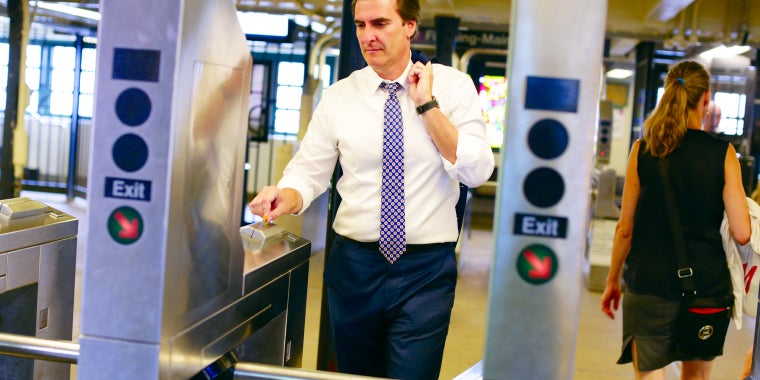
Queens Daily Eagle: Queensboro Plaza to get accessibility upgrades

A new elevator is coming to the Queensboro Plaza subway station after a private developer received city approval to build the accessibility upgrade in exchange for the right to build more stories in a nearby residential development last week.
The deal between Grubb Properties and the city’s Department of City Planning and the MTA was struck under the city’s new Zoning for Accessibility text amendment, which passed last fall. The elevator project at Queensboro Plaza marks not only the first time the new zoning law has been used in Queens, but the first time it’s been used outside of Manhattan.
“This is a huge win for transit riders, and further proof that Zoning for Accessibility will continue to deliver results for New Yorkers,” said Department of City Planning Director and City Planning Commission Chair Dan Garodnick.
The accessibility project, which is being constructed on the northern side of Queens Plaza, is part of Grubb Properties development of 25-01 Queens Plaza North. The 26-story residential tower will include a little over 400 units, 30 percent of which would be deemed affordable.
Had Grubb Properties not utilized the text amendment, it would only be allowed to build 16 stories high under zoning regulations in the neighborhood.
The project was not required to be put through the city’s Uniform Land Use Review Procedure, but needed approval by the CPC, which was granted on July 27. The developer also presented its plans to Queens Community Board 1, which wrote a letter in support of the project in June.
As part of the deal, Grubb Properties will install the new elevator for access to the station mezzanine level and replace the current subway entrance. The developer will be responsible for maintenance of the staircase on the north side of the station, as well as elevator improvements.
Separate from Grubb Properties’ project, the MTA is constructing two elevators on the south side of the station, which spans from one end of Queens Boulevard to the other.
The text amendment, which aims to encourage private developers to build elevators and other accessibility improvements in the city’s subway system, only applies to developments proposed within 500 feet of a station, or within 1,500 feet of a station in a central business district – Queens’ only central business district is Long Island City.
In some cases, developers building near a subway station in a high density area would build and maintain an elevator or subway entrance in exchange for a 20 percent density bonus. In other situations, the developer would give the MTA the rights to a section of their land and the transit agency would make the accessibility improvements.
Grubb Properties will be responsible for the construction and maintenance of the elevator – as well as the cost.
The start of the use of the text amendment comes during the 32nd anniversary of the passage of the Americans with Disabilities Act, and only weeks after the MTA committed to making 95 percent of the city’s subway stations accessible by 2055 as part of a settlement agreement in two separate lawsuits regarding the city’s violation of the ADA.
In Queens, 22 of the borough's 82 stations are compliant with the Americans with Disabilities Act. The text amendment opens the door for 14 more Queens stations to come into compliance with the law, according to the MTA. There are around 130,000 Queens residents who either use a wheelchair or have difficulty walking due to a disability.
“New York depends on mass transit, and mass transit needs to be available and accessible to all New Yorkers,” MTA Chair and CEO Janno Lieber said in a statement. “The improvements at Queensboro Plaza demonstrate how the MTA is using every possible strategy to make the entire subway system ADA accessible.”
In June of last year, as the text amendment was being considered by community boards across the city, disability advocates told the Eagle that they were skeptical the text amendment could do much to improve the city’s poor record on subway accessibility.
Advocates were particularly concerned about the fact that the accessibility features would be maintained by private developers.
In 2019, the worst performing escalator in the subway system – inside the Lexington Avenue-53rd Street station – and the worst performing elevator in the system – inside the Aqueduct Racetrack A train stop – were both owned and maintained by a private operator, according to reporting by THE CITY.
“We're skeptical about what hours and days those entrances will be open,” Jean Ryan, the president of Disabled in Action of Metropolitan New York, told the Eagle in 2021. “Because there are private subway entrances that are closed sometimes, like, nights and weekends. And because they're in a private building – how would that help us?”
However, approval of the Queensboro Plaza project was celebrated by a number of local elected officials this week.
“New York has been behind the world on transit accessibility, and I am glad major stations like Queensboro Plaza, and Court Square are finally being upgraded,” said Senate Deputy Leader Michael Gianaris. “For New York to thrive, it must have an MTA for All, where everyone can access the subway system to get to work, school and around our city.”
City Councilmember Julie Won said that while the improvements are necessary to make New York City life livable for those with mobility issues, it also eases a burden for those with young children, as well as the elderly.
“Accessible public transportation is essential to the bloodline of New York City, connecting us from borough to borough,” Won said. “Every new elevator the MTA installs is another mom, like me, being able to bring her child and a stroller onto the 7 train, as well as our seniors and neighbors with disabilities having universal access to fast and cheap transportation.”
“Queensboro Plaza is the gateway to Queens and the MTA’s upcoming elevators will benefit thousands and thousands of subway riders throughout Queens and our city,” the councilmember added.



